AN EVENING OUT
DigitalFocus Rings in New Year
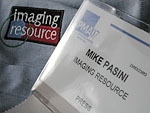 By MIKE PASINI
By MIKE PASINIEditor
The Imaging Resource Digital Photography Newsletter
LAS VEGAS, Nev. -- Yes, there was the free Wynn Hotel shuttle from the Las Vegas Convention Center to Treasure Island Hotel where we would be attending Pepcom's DigitalFocus preview event with a Chinese New Year theme. And a long line for cabs. But doing the math, Senior Editor Shawn Barnett calculated a limo would be cheaper than two cabs.
|
|
So off we went in a limo, the video gear in the trunk as collateral and Michael Tomkins working the interior lighting like it was just another wireless flash setup. It occurred to us it was a little absurd to be taking a limo to an event where we were all quietly lusting for handout Energizer batteries. But that's what makes our coverage special. We see all the angles.
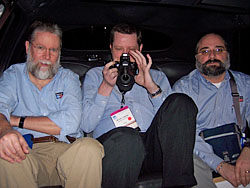
Limo. Luke, Michael and Shawn enroute.
They may have been handouts, but the Energizer batteries weren't quite free. We had to listen to a rigmarole about the advantages of lithium AAs. Disposable, one-use lithiums, that is.
If you've been paying attention, we always recommend you get a set or two of NiMH rechargeables and a nice charger (like the Maha bundles). They last forever and save you a fortune in single-use batteries.
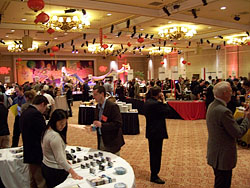
Overview. Raise high the chandeliers and drop the lanterns.
But you do have to keep them charged. We keep a set in a charger and pop the freshly toppd-off cells into our camera before we venture out on a shoot. It's an old habit by now.
But not everyone is so well disciplined, Energizer evangelist Elizabeth Sedlock explained. Some people only use their digicams once or month or two. For them, buying a set of four AA lithiums for $10 is smart because lithiums don't need to have their charge maintained when you don't use them. And they also handle temperature extremes better than alkalines (which you should never use anyway) because there's no water in them.

The Band. Music but no MP3s.
The real comparison is with NiMH rechargeables, not alkalines, we kept insisting.
Then she said something interesting. Recent advances in NiMH rechargeables (which Energizer does sell in 2500 mAh capacities) now make it possible for a fully charged set to hold nearly 80 percent of its charge up to five years. Which kind of kills the lithium argument, but sounds great to us.
Energizer sells a compact charger that can charge four cells in a pod that doubles as a carrying case. The $39.99 Dock & Go looked review worthy to us, so we asked her to send one.
We got our samples, though, and moved on to the PanDigital (http://www.pandigital.net) table. The company recently sent us one of their 8-inch digital photo frames and we were in the midst of reviewing it when it was time to leave for the airport to attend the show.
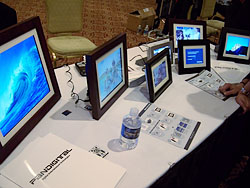
Pandigital. The current line-up (so to speak).
PanDigital distinguishes itself from its many competitors by being the first to use an MP3 player chipset rather than a DVD player chipset in its frames. This makes image transfers to its large internal flash memory fast, for one, but generally improves performance and connectivity.
PanDigital President Dean Finnegan told us the company sold 520,000 frames in the last quarter of 2006, 70 percent of the buyers female and they bought 1.8 frames, coming back for a second frame after the delight of experiencing the first. They're in 6,000 retail outlets including Macy's, Mervyn's, Office Depot and more.
The small remote (whose battery lasts forever, Finnegan promised us) is shaped like a CompactFlash card so it can be stored in the CompactFlash slot, a neat idea.
We asked why the 8-inch frame we're reviewing was so bright compared to the LCD monitors connected to our computers (the nice LCD monitors, we should say). Finnegan explained that model (which can display millions of colors) doesn't use fluorescent lamps to illuminate the screen but backlit LEDs. And newer models will all use that technology.
In fact, the company is looking forward to updating the chipset in June with some exciting new options, which (as options) also keeps the base price low. One is Wireless B/G connectivity. Another is a lithium-ion battery (so you can hang the thing of the wall and forego the power brick except to recharge it). The chipset also supports a timer for turning the frame on and off at regular intervals. And supports more document formats so you can store recipes in the internal memory, bring it into the kitchen and cook with it. And it will allow the housing to be thinner.
We wondered how people use the things. Do they leave them on or only turn them on when they want to look at them? Do they use them like a real framed photo or more like a television.
Finnegan said you can really just leave them on. They use very little power, the LED backlight version consuming 25 percent less than conventional LCDs.
The company uses only A grade panels, he said, from the same source as Sony's LCD TVs. They have almost no returns.
Which surprised us because when we were researching the review, we Googled PanDigital and found some nasty comments on amazon.com. Finnegan knew all about that. He even knows who one of the posters is. But there's nothing he can do about, he said. Amazon told him to write his own reviews for it.
But we have a better idea. Stay tuned for our review.
WESTINGHOUSE | Back to Contents
Also at DigitalFocus showing photo frames was Westinghouse (http://www.westinghousedigital.com), whose housings looked an awful lot like PanDigital's. But that was the end of the similarities.
The Westinghouse frames don't come with a remote. In fact, you can't control them at all. They run by themselves in either full frame mode or in what he company calls MosaicView, which can display four images simultaneous, swapping one out at a time. You can also simply display the same four images.
Sure, there were a number of camera companies with tables, including Canon, Olympus, Nikon, Panasonic and more, but we'll defer high-end camera coverage to our video crew while we keep looking for those price-barrier breaking bargains.
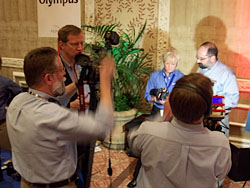
Video Crews. Covering Olympus here with two cameras.
Besides free batteries, we had been looking forward to spending a few minutes with Maurice Hamoy of Noromis (http://www.noromis.com). The company has recently introduce its $49.95 PhotoLab Windows application to import, enhance and print digital photos, which can "intelligently and automatically adjust for exposure, contrast, color balance, saturation, sharpness, red-eye and digital noise."
Hamoy explained there are two ways to start the program. One is by connected an external device like a camera or USB thumb drive, which will prompt the program to import your images after asking if you want to edit out any red-eye during the transfer. The other, of course, is by simply launching it from the Start menu.
He counted no more than five mouse clicks to turn the images in your camera into prints on your printer. The program can automatically optimize the images, not just removing red-eye and improving brightness and contrast but also by performing little miracles like optimizing skin tone. It uses facial recognition to do that.
When you first run the program it goes through a geometric calibration of your printer that resembles print head alignment tests. A pattern is printed out and you tell PhotoLab where a line appears on the page. That guarantees that when you print bordered prints the border is absolutely even. "Printer drivers lie," Hamoy laughed. So PhotoLab tests them to see exactly what the printer does.
Edits made to the images don't actually change the pixels in the image but are stored in PhotoLab's database. The original image is never altered. That's the approach used by Aperture and Lightroom, too. Can PhotoLab be extended to handle Raw images, too? It can, Hamoy nodded. And they're considering it.
The company spent a lot of time developing the program's image analysis capability but it also spent a lot of time on usability and the user interface. It actually rigged up a test room with video cameras to record user's faces and the screens they were looking at. "When we say tears," Hamoy joked, "we knew we had to fix that part of the interface."
We've installed PhotoLab on our Windows test machine and plan to review it as soon as we wipe away our tears. We had a good laugh at the PhotoLab table.
Another piece of software that caught our attention was muveeNow (http://www.muvee.com). The Singapore-based company's earlier muvee offering is embedded in some Nikon Coolpix models and in some kiosks as well. The new version is a stand-alone Windows application that, they company said, makes it a three-step process to create a video presentation from stills or video.
We watched the demo and it was indeed simple. Step One is to select the images or video clips you want to use. Step Two is to pick the MP3 music file you want to use and the template for the production. A number of templates ship with the product and more are available online at an additional charge. Step Three is to play the production.
It was so easy to create a pleasing video production that the process actually seemed to us to encourage revision. And that can't be a bad thing. Have one too many photos? It's no big deal to go back to Step One to revise what's included.
The program analyzes both the images (with face recognition at play here too) and the music to match transitions to the beat. And it does it quickly, too. There's a lot of what the company calls "artistic intelligence" at work behind the scenes.
And the results speak for themselves.
We had a chance to meet with Microtek's Parker Plaisted to discuss the whereabouts of the long-awaited M1 scanner (http://www.microtek.com). They've actually wrapped up the hardware side of it but are still working with another firm on the software.
We asked him about i900 large film scanning issue where some unevenness was reported in our forums. He thought it was most likely a flatness issue with the film. But he confessed he wasn't familiar with it.
He was familiar with LaserSoft's new SilverFast 6.5, which, he confirmed, dramatically improves the dynamic range of scanners it runs on. LaserSoft tests indicated two exposures were sufficient to capture highlight and shadow detail independently, merging the two like Photoshop's HDR format to enhance dynamic range.
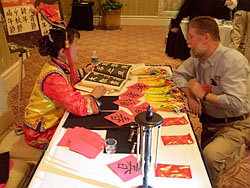
Receipt?. Find the digicam first.
In our excitement to get into the event, Shawn neglected to pester the limo driver for a receipt. So Luke sat down with a charming calligrapher and coaxed an equivalent out of her. Taken with his appreciation for her style, she brought out a few art books to show him the work of her favorite masters.
We were drawn to the exchange primarily because it was near the exit, but the site of an ink stone freshly rubbed and the elegant brushes made us hover like a moth near the table.
That's when we saw that behind her on the chair she had stashed a small silver digicam. There's just no escaping the things!